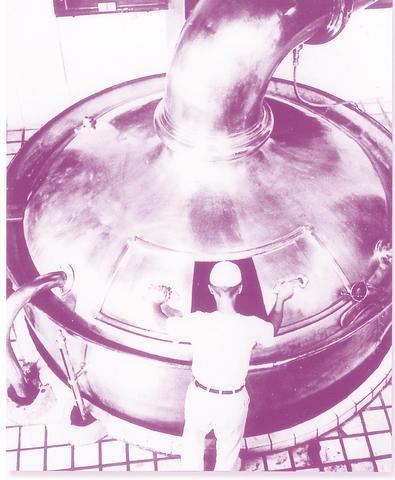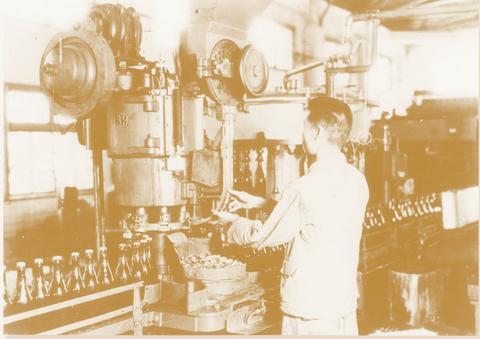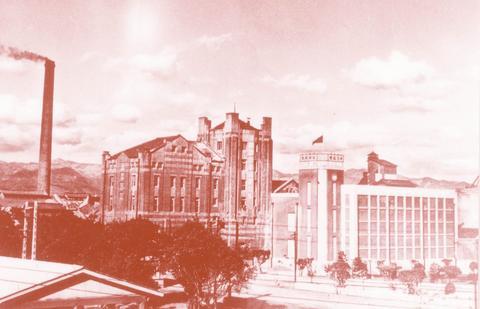Chienguo Brewery is the smallest of four breweries in Taiwan and the first large-scale brewing operation on the island. Built in 1919, during the Japanese colonial period, the brewery's first batches of Gaosha Beer (高砂麥酒) were being rolled out a year later to the delight of soldiers and civilians alike.
Officially, the brewery is no longer open to tours, but groups can arrange visits through the Taiwan Tobacco and Liquor Company (TTL). The Taipei Times arranged an extended tour of the facilities on the condition that no photographs be taken.

PHOTO COURTESY OF TTL
"What we do here is secret," said Tsao Wei-ching (曹維清), a brewmaster who's worked at Chienguo for the past 25 years and who would take time out of his schedule to serve as tour guide. But first, a toast: "Welcome to Chienguo Brewery," Tsao says. "Gan bei!"

Touring a brewery is a hell of a thing to do at 8am. Visitors are greeted by the thwack sound of a newborn bottle of beer being opened regardless of the time of day. Any thought you may have had that being a brewer is an enviable job vanishes with the gases wafting up and out of the fermentation vats.
"Before Gaosha, all the beer in Taiwan was imported from Japan," Tsao explains at the start of the tour. "But before long, Gaosha was being shipped back to Japan and eventually became just as popular as Sapporo Beer."

To understand how important the brewery was to the Japanese, it was built using the same bricks used to build the Japanese Governor's Palace, now the Presidential Building.
In 1945, with the arrival of Nationalist troops from China, the brewery became the Taipei Beer Company and was the sole brewer of Taiwan Beer until a second brewery was opened years later and it was renamed the Taipei Second Brewery. It was given its present name in 1975.
Many changes
But its name was not the only thing to change over the years. From the late 1940s to the 1950s on-site facilities included a nursery school and a large elementary school for the children of brewery employees. Additional buildings were added and some older facilities were dismantled to make room for the modernization of the brewery.
That modernization culminated in 1992, when the brewery became largely automated and brewmasters were replaced with computers. That same year saw the brewery's peak of production with 700 employees brewing, bottling, capping, labeling and shipping 144 million bottles of beer. ["Take one down, pass it around, 139,999,999 bottles of beer on the wall!"]
Other changes included the elimination of both kegs and the smaller 0.35-liter bottles in favor of the current 0.6-liter variety, though other breweries in Taiwan continue to package their product in these larger sizes.
The most recent change has come in the form of competition. The introduction of beers from China, most notably Tsingtao, has impinged on Taiwan Beer's previous monopoly. But the home brew maintains 80 percent of Taiwan's US$6.5 billion market, according to TTL statistics.
However, the dip in market share has contributed to the scaling back of production at Chienguo. In fact, the place was almost shut down four years ago, though the official reason given was because of noise and pollution complaints from the neighboring community. Instead, production was scaled back, part of the land was given over to the construction of junior high school, and the Taipei City Government Cultural Affairs Bureau designated the remaining property an historical landmark. It is now staffed by 95 people producing 2 million bottles a year.
More changes are on the horizon. Taipei's Cultural Affairs Bureau is brewing plans of its own to turn the site into a recreational area with operational brewing facilities on a limited scale. The building that hides the facilities built in 1919 is to be razed and the original buildings refurbished.
The one thing that has not changed over the years, according to Tsao, is the recipe. Like its predecessor, Gaosha, Taiwan Beer is a lager and undergoes a cold-fermentation process that allows the yeast to settle and be removed, giving the finished product greater carbonation and a golden coloring rather than a hazy amber. Also like Gaosha, Taiwan Beer has penglai rice (蓬萊白米) added to it, along with the malt and hops. This, Tsao explains, is what gives Taiwan Beer its award-winning taste. It won the gold medal at the World Selection for Beer in Geneva in both 1978 and 1988 and earned a silver medal in the Brewing Industry International Awards in 2002.
The tour finishes in the back of the brewery grounds under a canopy of corrugated metal, where a matrix of machines, pipes and conveyor belts converge: a bottle washer that scrubs the labels and sanitizes thousands of bottles at a time, a beer filler and capper that produces 550 bottles of beer per minute, a pasteurizer that showers those bottles in hot water for an hour, and finally a labeler and caser that readies the bottles for store shelves.
In an office overlooking the whole operation, several brewers take their lunch breaks, enjoying bian dang and, not surprisingly, bottles of beer. Here, the tour ends as it began, with a toast: "To Taiwan Beer! The best beer in the world!" Tsao says.

Eric Finkelstein is a world record junkie. The American’s Guinness World Records include the largest flag mosaic made from table tennis balls, the longest table tennis serve and eating at the most Michelin-starred restaurants in 24 hours in New York. Many would probably share the opinion of Finkelstein’s sister when talking about his records: “You’re a lunatic.” But that’s not stopping him from his next big feat, and this time he is teaming up with his wife, Taiwanese native Jackie Cheng (鄭佳祺): visit and purchase a

April 7 to April 13 After spending over two years with the Republic of China (ROC) Army, A-Mei (阿美) boarded a ship in April 1947 bound for Taiwan. But instead of walking on board with his comrades, his roughly 5-tonne body was lifted using a cargo net. He wasn’t the only elephant; A-Lan (阿蘭) and A-Pei (阿沛) were also on board. The trio had been through hell since they’d been captured by the Japanese Army in Myanmar to transport supplies during World War II. The pachyderms were seized by the ROC New 1st Army’s 30th Division in January 1945, serving

The People’s Republic of China (PRC) last week offered us a glimpse of the violence it plans against Taiwan, with two days of blockade drills conducted around the nation and live-fire exercises not far away in the East China Sea. The PRC said it had practiced hitting “simulated targets of key ports and energy facilities.” Taiwan confirmed on Thursday that PRC Coast Guard ships were directed by the its Eastern Theater Command, meaning that they are assumed to be military assets in a confrontation. Because of this, the number of assets available to the PRC navy is far, far bigger

The 1990s were a turbulent time for the Chinese Nationalist Party’s (KMT) patronage factions. For a look at how they formed, check out the March 2 “Deep Dives.” In the boom years of the 1980s and 1990s the factions amassed fortunes from corruption, access to the levers of local government and prime access to property. They also moved into industries like construction and the gravel business, devastating river ecosystems while the governments they controlled looked the other way. By this period, the factions had largely carved out geographical feifdoms in the local jurisdictions the national KMT restrained them to. For example,